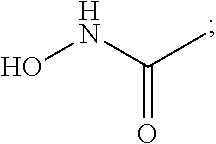N-substituted tetrahydroisoquinoline/isoindoline hydroxamic acid compounds
a technology of isoindoline and tetrahydroisoquinoline, which is applied in the direction of biocide, plant growth regulator, organic active ingredients, etc., can solve the problem of limited data published regarding the specificity of histone deacetylase inhibitors
- Summary
- Abstract
- Description
- Claims
- Application Information
AI Technical Summary
Benefits of technology
Problems solved by technology
Method used
Image
Examples
examples
1. N-Hydroxy-2-(indol-3-ylacetyl)-1,2,3,4-tetrahydroisoquinoline-6-carboxamide hydrochloride
[0206]180 mg 2-(1H-indol-3-ylacetyl)-N-(tetrahydro-2H-pyran-2-yloxy)-1,2,3,4-tetrahydroisoquinoline-6-carboxamide are dissolved in methanol and 6 ml of a solution of 0.1 M HCl in water are added drop wise. The mixture is stirred overnight. The mixture is evaporated in vacuo and the residue is treated with a mixture of water and acetonitrile and lyophilized. 92 mg (63%) of the title compound are obtained. MH+=350.0
2. N-Hydroxy-2-(pyridin-2-ylacetyl)-1,2,3,4-tetrahydroisoquinoline-6-carboxamide hydrochloride
[0207]A mixture of 75 mg 2-(pyridin-2-ylacetyl)-N-(tetrahydro-2H-pyran-2-yloxy)-1,2,3,4-tetrahydroisoquinoline-6-carboxamide and 6 ml of a 0.1M solution of HCl in water in 4 ml methanol is stirred overnight at ambient temperature and evaporated. The mixture is dissolved in a mixture of 2 ml water and 2 ml acetonitrile and lyophilized. 75 mg of the title compound are obtained as colorless sol...
PUM
| Property | Measurement | Unit |
|---|---|---|
| temperature | aaaaa | aaaaa |
| pH | aaaaa | aaaaa |
| pH | aaaaa | aaaaa |
Abstract
Description
Claims
Application Information
 Login to View More
Login to View More - R&D
- Intellectual Property
- Life Sciences
- Materials
- Tech Scout
- Unparalleled Data Quality
- Higher Quality Content
- 60% Fewer Hallucinations
Browse by: Latest US Patents, China's latest patents, Technical Efficacy Thesaurus, Application Domain, Technology Topic, Popular Technical Reports.
© 2025 PatSnap. All rights reserved.Legal|Privacy policy|Modern Slavery Act Transparency Statement|Sitemap|About US| Contact US: help@patsnap.com



